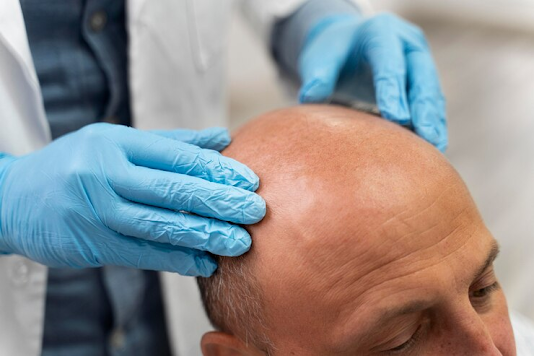What Is the Success Rate of Best Hair Transplant?
When it comes to restoring hair, one of the most popular and reliable methods is the Best Hair Transplant. Whether you’re dealing with thinning hair or baldness, a hair transplant offers a lasting solution, but how successful are these procedures? The success rate of a hair transplant largely depends on the skill of the doctor and the technique used. A well-performed transplant can lead to natural-looking, fuller hair. In cities like Dubai, where the demand for aesthetic treatments is high, people often seek the Best Hair Transplant Dubai for superior outcomes.
Understanding Hair Transplant Procedures
A hair transplant is a surgical procedure where hair follicles are moved from one part of the body (typically the back of the head) to areas where hair is thinning or bald. The procedure is performed by a skilled surgeon who ensures that the hair follicles are transplanted in the most natural way possible. There are two main techniques used in hair transplant surgery: Follicular Unit Extraction (FUE) and Follicular Unit Transplantation (FUT).
FUE: In this method, individual hair follicles are extracted and transplanted to the thinning or bald areas. It leaves tiny, almost invisible scars, making it a popular choice for many patients.
FUT: Also known as the strip method, FUT involves removing a strip of scalp from the donor area and dissecting it into follicular units for transplantation. Although this method leaves a linear scar, it allows for the transplantation of a large number of grafts in one session.
The doctor’s expertise in choosing and performing the right technique is key to ensuring the best results. It’s crucial to choose a surgeon who has a high level of experience and training in hair transplant procedures.
 |
Factors Affecting Success Rates
The success of a hair transplant is influenced by several factors. Let’s take a look at what plays a role in ensuring a successful outcome:
1. Doctor’s Expertise and Skill
The most important factor in the success of a hair transplant is the experience and skill of the doctor. An expert surgeon will ensure that the hair follicles are carefully extracted and placed in the correct direction and angle, allowing the hair to grow naturally. They will also consider the density and type of hair to match the transplanted hair with the existing hair, ensuring a seamless result.
2. Patient’s Health and Age
A patient's overall health and age can also impact the success of a hair transplant. Younger patients with early stages of hair loss typically see better results, as their hair follicles are still in a more robust state. Additionally, patients who are healthy with no underlying conditions like diabetes or scalp infections have a better chance of successful hair regrowth.
3. Hair Quality and Density of Donor Area
The quality and density of hair in the donor area (typically at the back of the head) play a crucial role. The higher the density of hair in this area, the more follicles can be harvested for transplantation, leading to fuller results. It’s important for the surgeon to assess whether the donor area has sufficient healthy follicles to achieve the desired outcome.
4. Post-Operative Care
Proper aftercare is essential for the success of a hair transplant. Following the doctor’s post-operative instructions, such as avoiding strenuous activities and protecting the transplanted area from direct sunlight, is crucial. Patients should also follow the hair washing and medication guidelines provided by their surgeon to promote the healing process.
5. Natural Healing Process
The natural healing process can take several months, and the hair follicles need time to take root and start growing. Typically, it can take anywhere from 6 to 12 months for the transplanted hair to fully grow and for the results to be visible. Patience is essential, as premature judgment about the success of the procedure can lead to disappointment.
Success Rate of Hair Transplants
The success rate of a Best Hair Transplant is typically very high, ranging from 85% to 95% for most patients. This high success rate is attributed to the advanced techniques used today, such as FUE and FUT, which have been refined over the years. However, the final success rate will depend on the factors mentioned above, such as the surgeon’s skill, the patient’s health, and how well they follow post-operative care instructions.
It’s important to remember that some shedding of transplanted hair is normal in the first few weeks after surgery. This is often followed by new hair growth, and the final result is usually noticeable after 6 to 12 months. A small percentage of patients may experience complications, such as infection or poor growth of transplanted hair, but these are relatively rare and can usually be managed effectively by the doctor.
Benefits of the Best Hair Transplant
1. Permanent Solution
One of the main benefits of the Best Hair Transplant is that it provides a permanent solution to hair loss. Since the transplanted hair follicles come from areas of the scalp that are resistant to balding, the new hair is permanent and won’t fall out. This means that once the transplant heals, patients can enjoy a full head of hair for life.
2. Natural-Looking Results
When performed by an expert doctor, a hair transplant produces natural-looking results. The transplanted hair will grow in a way that matches the natural growth pattern of the patient’s existing hair. This ensures that the results look undetectable and blend seamlessly with the rest of the hair.
3. Boosts Confidence
Hair loss can be emotionally taxing for many individuals, but a successful hair transplant can have a transformative impact on self-esteem. Patients often experience a significant boost in confidence after the procedure, as they no longer have to worry about bald spots or thinning hair.
4. Low Maintenance
Once the transplanted hair has fully grown, it requires very little maintenance. Unlike wigs or other temporary hair loss solutions, transplanted hair is permanent and can be treated just like natural hair. Patients can cut, color, and style it without any restrictions.
5. Minimal Scarring
Thanks to advanced techniques like FUE, hair transplant procedures leave minimal scarring, making it an ideal choice for those who want to avoid noticeable scars. The tiny scars from FUE are typically undetectable, even under short haircuts.
Conclusion
The success rate of the Best Hair Transplant is high, with most patients seeing excellent results. The key to success lies in choosing a skilled doctor who can perform the procedure with precision and care. With the right technique, post-operative care, and patience, patients can enjoy permanent, natural-looking hair that boosts their confidence. If you’re considering a hair transplant in a world-class destination like Dubai, opting for the Best Hair Transplant Dubai ensures you receive top-notch treatment with outstanding results.



Comments
Post a Comment